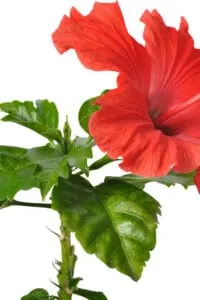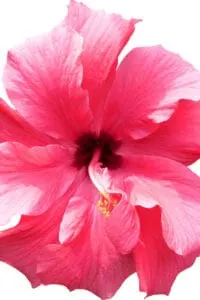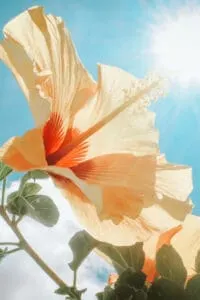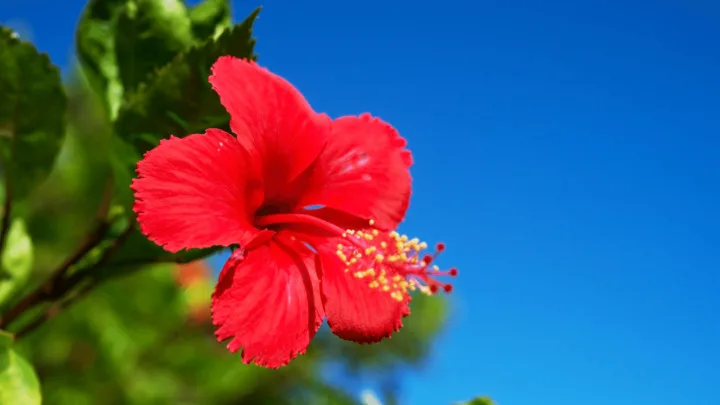In this article, I am going to discuss the best fertilizers for hibiscus.
Hibiscus is my favorite summer flower because they come in a variety of colors (pink, orange, white, yellow, red, etc.) and also because they remind me of my trip to Hawaii.
Although they do not demand any special care, a steady dose of fertilizer is important to help these tropical beauties bloom perfectly throughout the summer.
The exciting thing about growing Hibiscus is that you can grow it as a full tree in your summer garden or in a pot; it will reward you with colorful blooms in both ways.
Other than regular watering, fertilizing is the only requirement for your Hibiscus to grow healthy.
In this guide, I’m discussing what type of fertilizer is best for Hibiscus and when is the best time to fertilize them.
We get commissions for purchases made through links in this post.
Best Fertilizers for Hibiscus
The best fertilizers for hibiscus are high in potassium (K), have a medium amount of nitrogen (N), and are low in phosphorus (P). such as NPK 10-5-20. Fertilize every 2 weeks in the growing season using a liquid fertilizer or every 8 weeks using a slow-release fertilizer.
The best fertilizers for hibiscus are:
- Best Overall Hibiscus Fertilizer – Exotic Blend by Dr. Earth
- Best Slow-Release Hibiscus Fertilizer – Earthpod Hibiscus and Tropical Flower Formula
- Best Fertilizer for Potted Hibiscus – Hibisgain by BGI Fertilizers

Best Fertilizers For Hibiscus
Table of Contents
Best Fertilizers for Hibiscus
Best Overall Hibiscus Fertilizer – Exotic Blend by Dr. Earth
This organic fertilizer is a must-have for Palm, Hibiscus, and tropical plant gardeners.
This fertilizer is pet and people-friendly. It is rich in carbohydrates, proteins, humic acids, and multi-minerals.
It also has trace elements to promote soil health.
Customers have claimed that this brought their dying Hibiscus plants back to life.
This plant nutrition will ensure larger and more vibrant blooms on your Hibiscus.
I have also noticed that my Hibiscus plants produce more blooms after using this fertilizer. The nutrient ratio or NPK in this fertilizer is 6-4-6.
To make fertilizer tea, mix 5 cups of the fertilizer in 5 gallons of water and let the solution sit for one day.
Strain the mixture, and it is ready to use as mulch.
The liquid can also be used through foliar or soil application.
Some gardeners also use it as a compost starter to enhance the compost pile.
For established Hibiscus plants, use ½ of fertilizer for every foot of plant height and work the fertilizer in the soil around the base.
Always water the soil to complete the fertilization.
The application should be repeated every 2 months from early spring to late summer, i.e. the growing seasons.
For new Hibiscus plantings, add 1 cup of fertilizer to the planting hole and later add another cup to the soil around the plant base.
For established Hibiscus plants in containers, use 2 tablespoons for a 6-inch diameter pot.
For new plantings of Hibiscus in pots, mix 2 tablespoons of fertilizer in soil and water well. For optimum results, make sure the soil pH falls between 5-6.5.
The quality of this organic fertilizer is verified by Organic Material Review Institute (OMRI), California Certified Organic Farmers (CCOF), Organic Input Materials (OIM), and National Organic Program (NOP).
Pros
- The only non-GMO fertilizer in the USA
- Zero chemical content or toxic ingredients
- It can be used for other home-grown foods
Cons
- Has a very strong, unpleasant smell, which makes it difficult to use on indoor plants
- Some customers have complained about mold growth after using this fertilizer

Use fertilizer for hibiscus during the growing season
Best Slow-Release Hibiscus Fertilizer – Earthpod Hibiscus and Tropical Flower Formula
Earthworm Technologies was established with an aim to provide high-quality plant food for enthusiastic gardeners.
All their products were designed to have a positive impact on the environment.
This formula is a perfect fertilizer for indoor and outdoor tropical flowers such as a Hibiscus.
It’s a pack of 100 fertilizer spikes that can boost the roots, color, flowers, and foliar growth on Hibiscus plants.
You can also use it for other tropical plants like Bougainvillea, Bird of Paradise, Passion Flower, etc.
Since the fertilizer is enclosed in small pods, you don’t have to have to measure anything or tolerate the awful fertilizer smell.
The manufacturer claims that you will have a steady 4 years of supply for a single Hibiscus plant. Therefore, it is a long-lasting fertilizer.
This slow-release fertilizer is easy to apply. All you have to do is bury the earthpod in the potting mix near the base of the Hibiscus.
Add water to the soil, and the earthpod will slowly release the fertilizer for the roots.
This flower fertilizer is developed with a special blend of ingredients such as soil organisms, humates, organic nutrients, and other trace minerals to replicate the organic forest soil composition.
The beneficial bacterial and root fungi will support the root system of the Hibiscus.
Pure worm casting and sea products are the secrets behind the success of this formula.
The small pod design makes it very easy to fertilize Hibiscus in containers or hanging baskets. But you can also use this fertilizer for garden beds.
It should be applied every 2 or 3 weeks. Generally, for small plants, 1-2 pods should be used.
For medium-sized plants, 2-4 pods should be used, and for large, established Hibiscus, use 4-8 pods.
You have to take extra care to store these in a cool and dry location because a humid environment can result in an early breakdown of the pods.
Pros
- Easy to store and recycle
- It can act as a bloom booster
- Biological plant root organisms enhance root growth
- Approved by the USA soil science laboratory for excellent nutrient and microbial content
- A unique blend of all-natural minerals and nutrients
- Easy to apply with no measuring cups
- It is vegan and has no urea
- Suitable for plants growing in a soilless medium by opening the capsules
Cons
- Although the application is easy, you have to make sure the capsule or pod is completely surrounded by soil for nutrient breakdown
- Expensive for gardeners with a huge collection of tropical flowers
Learn more about this fertilizer here.

Hibiscus plants are heavy feeders
Best Fertilizer for Potted Hibiscus – Hibisgain by BGI Fertilizers
This fertilizer is designed specifically for Hibiscus to support their growing habits. It is used by home and commercial growers for Hibiscus gardening.
The NPK in this fertilizer is 12-6-8, and it also has other minor nutrients.
It does not require any mixing. Apply it directly to the soil. For potted Hibiscus, the rate of fertilizer depends on the size of the pot; 6 inches pot needs 1 tablespoon. Add 1 tablespoon for 4 inches increase in diameter.
According to the manufacturer, this fertilizer should be kept away from the foliage. Therefore, you cannot use the foliar application.
Soil application is the recommended method but make sure you sprinkle the fertilizer evenly.
If you accidentally get the fertilizer on the leaves, make sure you wipe it off to avoid any leaf injury.
For in-ground Hibiscus, the amount of fertilizer depends on the height of the plant. Starting from 2 tablespoons for a 2 or 3 ft high plant.
Regular application will soon result in glossy green leaves and large colorful flowers.
The blooms will last longer, and your plant will bloom throughout the season.
For healthy Hibiscus plants, apply the fertilizer at least once in the growing season.
The rule of thumb is to fertilize less but regularly, so adjust the fertilization schedule accordingly.
However, always make sure you follow the instructions on the label.
The convenient handle and sealable package make this fertilizer easy to use and store.
Pros
- It comes with a resealable package
- Tested formula for Hibiscus growth
- Economical for potted Hibiscus plants
Cons
- Using it on plants other than Hibiscus can result in crop injury
- Expensive for some growers
Buy this fertilizer here.

Always water the soil when fertilizing hibiscus
Best Granular Hibiscus Fertilizer – Hibiscus and Flowering Tropicals Fertilizer by Nelson Plant Food
The NPK ratio for this Hibiscus plant food is 10-4-12. In my opinion, this fertilizer is a perfect source of food for any Hibiscus variety.
It also contains sulfur, magnesium, and iron, but the higher potassium content will promote bigger bolder blooms.
I like using this plant food for other tropical flowers in my garden as well. In the last season,
I have used it for Rose of Sharon, Texas Star Hibiscus, and Mallow Hibiscus, and all of them have shown excellent results.
Make sure you apply it once a month in the growing season.
The NutriStar formula increases the growth rate of vines, promotes heavy blooming, and increases the tolerance of plants against dry weather.
This fertilizer has been a popular choice for landscape flowers for almost 30 years.
The noteworthy point about this granular formula is that it provides the best nutrition to your plants instantly, and the slow-release nature ensures long term benefits.
For a 1-gallon container, use 1 tablespoon of fertilizer. You can also use this while transplanting Hibiscus, mix 1 ¼ cup of plant food in 1 cubic ft. of growing media before planting the Hibiscus in the media.
Water the plant thoroughly after transplanting.
If you plan to use it for landscape Hibiscus, sprinkle ½ cup of the plant food across a 10 sq ft area in your garden or yard.
Pros
- Suitable for both container and in-ground Hibiscus
- Has 2 sources for potassium and 5 sources for nitrogen
- Easy to use
Cons
- Some customers have complained about broken container
Best for Budget Hibiscus Fertilizer – Hibiscus Plant Food by Carl Pool
This plant food has a 10-4-12 nutrient ratio indicating it’s a well-balanced diet for Hibiscus.
It also contains other micronutrients such as sulfur to maintain optimum pH for Hibiscus growth.
This granular fertilizer should be applied every 4 to 6 weeks in the growing season.
A single application will produce new buds and blooms, but reapplying it regularly will result in several beautiful blooms throughout the year.
I tried it on one of my Hibiscus plant that was suffering from transplant shock. It soon recovered and turned lush and beautiful.
One of my Hibiscus plants was producing 4-8 blooms per day after this Hibiscus plant food. The blooms mostly lasted for 2 days.
It is sold in a 4-pound package. Many Hibiscus gardeners have appreciated this fertilizer for the perfect balance of ingredients.
For potted Hibiscus, use 1.5 teaspoons for a 1 gallon or 6-inch container. Make sure you water the soil thoroughly. Sprinkle the product evenly around your Hibiscus plant and work it into the soil.
I would highly recommend this product if your Hibiscus struggles during winter, as this well-balanced diet can save it from winter blues.
Pros
- Suitable for all Hibiscus varieties
- High sulfur ensures optimum soil pH
- Does not have any particular odor
- Can be applied to other plants
Cons
- The potassium content is not enough for long term use
- Not organic
- Expensive for commercial growers
Best Water-Soluble Hibiscus Fertilizer – Miracle-Gro All Purpose Fertilizer
This instant fertilizer will work like magic right after the first application.
This all-purpose fertilizer is safe to use on any plant variety, including Hibiscus because it will never burn your precious plants.
The NPK ratio for this Miracle-Gro product is 24-8-16.
The application should be repeated every 1-2 weeks in the growing seasons.
Always use according to label instructions to make sure your fertilizer does not mess with the soil pH.
It has a sufficient amount of macronutrients to help the Hibiscus in blooming, root growth, and photosynthesis.
Since it’s a water-soluble fertilizer, it dissolves faster and better in the soil for instant results.
Unlike granular or slow-release fertilizers, this product will not leave any residue or capsules in the soil.
This all-purpose fertilizer is easy to use on indoor, outdoor, potted, or in-ground Hibiscus.
But keep in mind it comes in a small package, so fertilizing a large landscape might be difficult and expensive.
Pros
- Worth the money because it can be used for other plants
- Water-soluble formula is easy to mix and apply
- Instant results
- Highly nutritional for Hibiscus and flowering varieties
Cons
- Expensive for large application
- Has a chemical smell
Learn more about this fertilizer here.
Water Soluble Fertilizer
This type of fertilizer is the best option for Hibiscus because it will dissolve faster in soil and show instant results.
For you, they are easier to apply, and for plant roots, they are easier to absorb.
I personally prefer liquid plant food or fertilizer for tropical plants like Hibiscus that need regular fertilization because I can conveniently fertilize my plant while watering, depending on the growth stage.
Water-soluble fertilizer is not only easy to add but also easy to remove.
If you end up over-fertilizing your plant with a water-soluble fertilizer, you can easily leach the soil with water to remove the excess fertilizer and start over.
Water-soluble fertilizers give you better control over the nutrient content, especially for soilless mixtures.
In simple words, they ensure maximum nutrients for your plants with minimum effort.
Did you know that water-soluble fertilizer is the top preference of most experts and new gardeners because of its easy application?
They also have stronger concentrations of nutrients compared to organic or granular fertilizers. But to prevent burns, you should strictly follow the instructions on the labels.
Winner: Miracle-Gro All Purpose Fertilizer
Which Nutrients are Important for Hibiscus?
Clemson University suggests that hibiscus should be fertilized every 8 weeks using a slow-release fertilizer and every 2 weeks using a liquid fertilizer in the growing season.
All types of Hibiscus need feeding for vigorous growth and color pigmentation.
Potted plants suffer more from a lack of nutrients compared to those growing in the ground, especially if you are using a peat potting mixture for your Hibiscus.
Potassium
Hibiscus plants need plenty of potassium because it supports the overall growth and metabolism of the plant.
Compared to other plants, Hibiscus needs a large amount of potassium because of the huge blooms.
A good fertilizer will not only help in blooming but also help the Hibiscus develop strong stems and roots.
This nutrient is responsible for all types of food, nutrient, and water transport throughout the plant system.
It is necessary for the development of colorful and complex Hibiscus flowers; therefore, try to maintain the required potassium content, especially during heavy blooming.
Phosphorus
Supplying the correct amount of phosphorus to your Hibiscus is important as a high dose of phosphorus can damage the plant.
Avoid using fertilizers or boosters with high phosphorus content because Hibiscus plants do not handle this nutrient very well.
Overdose of phosphorus will result in a stunted, yellow, and bloomless Hibiscus plant.
Most gardeners like fertilizing their flowering plants with bloom boosters, but based on my experience, they are not suitable for Hibiscus as they are high in phosphorus.
Nitrogen
All plants need a certain amount of nitrogen for healthy growth because it is found in chlorophyll and is needed for almost all metabolic processes.
Too much of it can burn the lush green leaves on your Hibiscus. Too little will stop the overall growth. Therefore, find a balance to avoid fertilizer burn.
You should stop feeding your plant in case of fertilizer burns until it recovers. Resume fertilization by using a weak solution.
For micronutrients, make sure you buy a Hibiscus fertilizer that has some amount of magnesium, copper, and iron.
What is the Best Time to Fertilize Hibiscus?
Hibiscus plants appreciate a light but regular application of fertilizer. This will result in a healthy plant that blooms frequently.
For slow-release fertilizer, I would suggest fertilizing at the following 4 stages:
- In early spring
- When the plant finishes the first cycle of blooming
- Halfway through summer
- At the beginning of winter
For most brands, slow-release fertilizer should be added every 3 or 6 months. Do not use them in cold winter months.
But keep in mind that most slow-release fertilizers are low in potassium; therefore, I do not prefer them for Hibiscus.
Otherwise, you have to supply potassium in some other way.
For water-soluble, liquid fertilizer, you should fertilize it every 2 weeks in spring and summer.
However, reduce the application to once every 4 weeks in autumn and winter.
When fertilizing your Hibiscus tree, make sure you spread the fertilizer in all the soil under the tree canopy.
This is important because some gardeners fertilize near the base only, but this does not feed the complete roots system.
Generally, the root system of Hibiscus extends to the edge of the tree canopy.
If you end up over-fertilizing your Hibiscus, you can fix the situation by adding phosphorus to the soil. The phosphorus will revive the blooms.
Extra Tips for Fertilizing Hibiscus
- Overfertilizing a Hibiscus should be avoided because it will cost you the most important thing; the blooms. Your Hibiscus will either produce few flowers or no flowers at all.
- Abide by the instructions on the package. A general rule for fertilizing Hibiscus is feeding in small amounts frequently rather than once in high amounts.
- For feeding your in-ground Hibiscus, I would suggest using a fertilizer feeder with your water hose to conveniently fertilize and water your plant at the same time.
- You can also mix your solution in a bucket and feed your plants one by one. Choose whatever method suits you, but make sure you never overfeed your Hibiscus.
- For potted Hibiscus, I would recommend adding the solution until it starts pouring from the bottom of the pot. This ensures all the potting soil is soaked in the solution.
- Always moisten the soil before fertilizing. Fertilizing dry soil can burn the roots.
- Hibiscus does not grow actively in winter. Therefore, it does not need any extra fertilizer. Reduce the rate of application or completely stop fertilizing in very cold months.
- Once the weather starts warming, you can resume fertilization by feeding once a week.
- If your Hibiscus is growing in full sun, it will require more feeding so fertilize accordingly.
- If you are using a fertilizer designed specifically for Hibiscus, it is safe to follow the dose rates given on the package. But if you are using any other type of fertilizer, it is best to dilute the solution by half for initial doses.
- Test the soil prior to fertilizing to adjust nutrient content in the soil for growing Hibiscus.
- My Hibiscus plants react better to early morning fertilization when the temperature is cool. If you fertilize at a high temperature, there is a high chance that most of the water-soluble fertilizer will be evaporated by the scorching sun.
- If you are situated in a warm area and temperatures are too high, watering the plant before and after fertilizing can help cool down the soil. Cool soil will also avoid root burns.
Conclusion About The Best Fertilizers For hibiscus
To conclude, the best fertilizers for hibiscus are fertilizers that have a medium amount of nitrogen, a low amount of phosphorus but a high amount of potassium.
Hibiscus plants love the summer heat, but they will also appreciate an extra dose of fertilizer.
For strong, colorful, and long-lasting blooms, you need the best fertilizer that has all the necessary ingredients for Hibiscus growth.
Just remember your Hibiscus will need more feeding in the summer months but cut back on fertilizer once winter arrives.
All the fertilizers mentioned in this guide are the best fertilizers for Hibiscus because they are tested and proven by several gardening experts, so choose your favorite and start feeding your hungry plants.
The extra tips given in this guide for fertilizing Hibiscus will surely help you achieve large and colorful blooms on this summer plant.

Daniel has been a plant enthusiast for over 20 years. He owns hundreds of houseplants and prepares for the chili growing seasons yearly with great anticipation. His favorite plants are plant species in the Araceae family, such as Monstera, Philodendron, and Anthurium. He also loves gardening and is growing hot peppers, tomatoes, and many more vegetables.
Last update on 2025-01-19 / Affiliate links / Images from Amazon Product Advertising API


